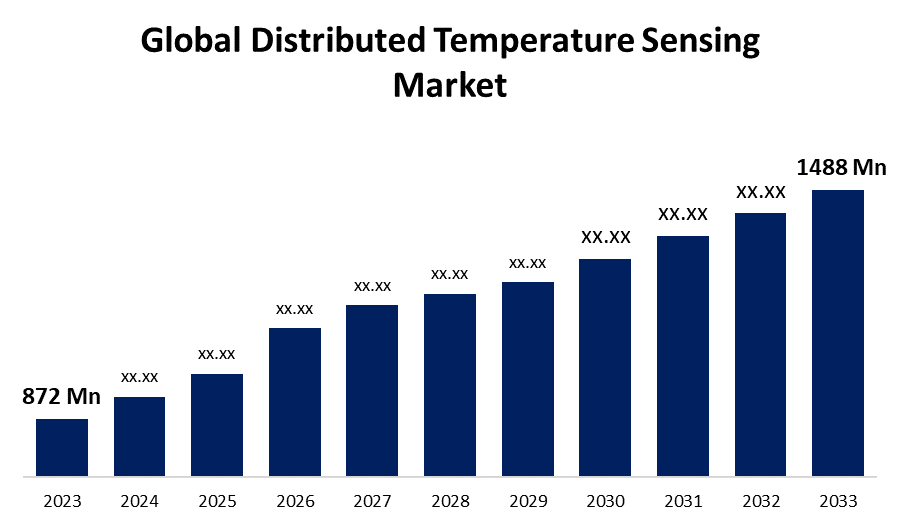Global Distributed Temperature Sensing Market Size, Share, and COVID-19 Impact Analysis, By Operating Principle (Optical Time Domain Reflectometry (OTDR) and Optical Frequency Domain Reflectometry), By Fiber (Single-mode Fiber and Multi-mode Fiber), By Application (Oil and Gas, Power Cable Monitoring, Fire Detection, Process & Pipeline Monitoring, Environmental Monitoring, and Others), and By Region (North America, Europe, Asia-Pacific, Latin America, Middle East, and Africa), Analysis and Forecast 2023 - 2033
Industry: Semiconductors & ElectronicsGlobal Distributed Temperature Sensing Market Insights Forecasts to 2033
- The Global Distributed Temperature Sensing Market Size Was Estimated at USD 872 Million in 2023
- The Market Size is Expected to Grow at a CAGR of around 5.49% from 2023 to 2033
- The Worldwide Distributed Temperature Sensing Market Size is Expected to Reach USD 1488 Million by 2033
- Asia Pacific is expected to grow the fastest during the forecast period.

Get more details on this report -
The Global Distributed Temperature Sensing market size was worth around USD 872 Million in 2023 and is predicted to grow to around USD 1488 Million by 2033 with a compound annual growth rate (CAGR) of 5.49% between 2023 and 2033. Improvements in optical fiber technology have made DTS systems more reliable and accurate, boosting their adoption across various industries.
Market Overview
The global distributed temperature sensing (DTS) market involves the development and sale of systems that use optical fibers to measure temperature along their entire length. These systems provide real-time, continuous temperature monitoring and are used in industries like oil and gas, power utilities, and environmental monitoring. The DTS technology is largely utilized in the oil and gas industry mainly for the petrochemical plants, pipeline structures, drilling, and storage tank areas to monitor the real-time temperature and vertical thermal profile. Due to its performance and capability of giving precise results in adverse environments, application industries are always inclined toward DTS. Distributed temperature sensing technology helps companies and professionals with its exceptional capabilities associated with immunity to electromagnetic interferences and high performance even in extreme temperatures. Governments are investing in smart grid projects to enhance the reliability and efficiency of power distribution networks. DTS systems are crucial for monitoring temperature along power cables and ensuring system stability.
Report Coverage
This research report categorizes the global distributed temperature sensing market based on various segments and regions forecasts revenue growth and analyzes trends in each submarket. The report analyses the key growth drivers, opportunities, and challenges influencing the global distributed temperature sensing market. Recent market developments and competitive strategies such as expansion, type launch, development, partnership, merger, and acquisition have been included to draw the competitive landscape in the market. The report strategically identifies and profiles the key market players and analyses their core competencies in each sub-segment of the global distributed temperature sensing market.
Global Distributed Temperature Sensing Market Report Coverage
| Report Coverage | Details |
|---|---|
| Base Year: | 2023 |
| Market Size in 2023: | USD 872 million |
| Forecast Period: | 2023 – 2033 |
| Forecast Period CAGR 2023 – 2033 : | 5.49% |
| 023 – 2033 Value Projection: | USD 1488 million |
| Historical Data for: | 2019-2022 |
| No. of Pages: | 230 |
| Tables, Charts & Figures: | 116 |
| Segments covered: | By Operating Principle, By Fiber, By Application, By Region |
| Companies covered:: | Bandweaver AP Sensing HALLIBURTON OFS Fitel, LLC NKT Photonics A/S Silixa Ltd OPTROMIX SLB Yokogawa Electric Corporation Sumitomo Electric Industries, Ltd. Others |
| Pitfalls & Challenges: | COVID-19 Empact,Challenges, Future, Growth, & Analysis |
Get more details on this report -
Driving Factors
DTS market is primarily growing due to its high usage in various application industries such as oil and gas, environmental monitoring, fire detection, and others. Rising awareness of workers' safety has also led to increased demand for distributed temperature sensing (DTS) equipment.
Restraining Factors
The technology of DTS offers the most accurate real-time data collection even in the most adverse conditions; however, it is costly and hence less adopted. Besides, the industries depend on cloud-based analytics, thus increasing the risks of cyberattacks.
Market Segmentation
The global distributed temperature sensing market share is classified into operating principle, fiber, and application.
- The optical frequency domain reflectometry segment accounted for the largest share in 2023 and is projected to grow at a substantial CAGR during the forecast period.
Based on the operating principle, the global distributed temperature sensing market is divided into optical time domain reflectometry (OTDR) and optical frequency domain reflectometry. Among these, the optical frequency domain reflectometry segment accounted for the largest share in 2023 and is projected to grow at a substantial CAGR during the forecast period. The growth can be attributed to the fact that the enhanced capacities enabled by the integration of OFDR with DTS, such as superior spatial resolution, accurate temperature measurements, and complex analysis required for real-time monitoring.
- The single-mode fiber segment accounted for the highest share in 2023 and is anticipated to grow at a remarkable CAGR during the forecast period.
Based on the fiber, the global distributed temperature sensing market is divided into single-mode fiber and multi-mode fiber. Among these, the single-mode fiber segment accounted for the highest share in 2023 and is anticipated to grow at a remarkable CAGR during the forecast period. The growth in segment can be attributed to factors such as small core diameters, minimized modal dispersion, high-performance abilities, long-distance signal transmissions, and benefits such as higher resolutions and immunity to electromagnetic interference.
- The oil and gas segment accounted for the highest share in 2023 and is anticipated to grow at a substantial CAGR during the forecast period.
Based on application, the global distributed temperature sensing market is divided into oil and gas, power cable monitoring, fire detection, process and pipeline monitoring, environmental monitoring, and others. Among these, the oil and gas segment accounted for the highest share in 2023 and is anticipated to grow at a substantial CAGR during the forecast period. This growth is primarily due to the rising need for safe alternatives for temperature monitoring, accurate data delivery, and cost-efficient solutions. Besides this, awareness regarding the safety of employees working in extreme conditions for longer hours is also a significant growth contributor for this segment.
Regional Segment Analysis of the Global Distributed Temperature Sensing Market
- North America (U.S., Canada, Mexico)
- Europe (Germany, France, U.K., Italy, Spain, Rest of Europe)
- Asia-Pacific (China, Japan, India, Rest of APAC)
- South America (Brazil and the Rest of South America)
- The Middle East and Africa (UAE, South Africa, Rest of MEA)
North America is anticipated to hold the largest share of the global distributed temperature sensing market over the predicted timeframe.

Get more details on this report -
North America is anticipated to hold the largest share of the global distributed temperature sensing market over the predicted timeframe. Industries in the region are investing in a system that ensures safe and secure working conditions. Similarly, strict environmental rules set by the US government are likely to boost the demand for distributed temperature sensing systems.
Asia Pacific is expected to grow at the fastest CAGR in the global distributed temperature sensing market during the forecast period. Expansion in the region due to urbanization and increasing demands for electricity transmission are projected to drive the adoption of the distributed temperature sensor system. The increased facility of oil, gas, and chemical plants across countries such as India and China are also anticipated to fuel demands for temperature and environmental monitoring solutions.
Competitive Analysis:
The report offers the appropriate analysis of the key organizations/companies involved within the global distributed temperature sensing market along with a comparative evaluation primarily based on their type of offering, business overviews, geographic presence, enterprise strategies, segment market share, and SWOT analysis. The report also provides an elaborative analysis focusing on the current news and developments of the companies, which includes type development, innovations, joint ventures, partnerships, mergers and acquisitions, strategic alliances, and others. This allows for the evaluation of the overall competition within the market.
List of Key Companies
- Bandweaver
- AP Sensing
- HALLIBURTON
- OFS Fitel, LLC
- NKT Photonics A/S
- Silixa Ltd
- OPTROMIX
- SLB
- Yokogawa Electric Corporation
- Sumitomo Electric Industries, Ltd.
- Others
Key Target Audience
- Market Players
- Investors
- End-users
- Government Authorities
- Consulting And Research Firm
- Venture capitalists
- Value-Added Resellers (VARs)
Recent Development
- In February 2025, AP Sensing recently launched the DTS N45-Series, which is designed for demanding applications. This new series offers the longest measurement range with 70 km and the best performance at shorter lengths with fast measurement times down to 1 second. It provides absolute precision and data security, making it suitable for various industries, including fire detection, high-voltage power cable monitoring, and oil and gas.
Market Segment
This study forecasts revenue at global, regional, and country levels from 2023 to 2033. Spherical Insights has segmented the global distributed temperature sensing market based on the below-mentioned segments:
Global Distributed Temperature Sensing Market, By Operating Principle
- Optical Time Domain Reflectometry (OTDR)
- Optical Frequency Domain Reflectometry
Global Distributed Temperature Sensing Market, By Fiber
- Single-mode Fiber
- Multi-mode Fiber
Global Distributed Temperature Sensing Market, By Application
- Oil and Gas
- Power Cable Monitoring
- Fire Detection
- Process and Pipeline Monitoring
- Environmental Monitoring
- Others
Global Distributed Temperature Sensing Market, By Regional Analysis
- North America
- US
- Canada
- Mexico
- Europe
- Germany
- UK
- France
- Italy
- Spain
- Russia
- Rest of Europe
- Asia Pacific
- China
- Japan
- India
- South Korea
- Australia
- Rest of Asia Pacific
- South America
- Brazil
- Argentina
- Rest of South America
- Middle East and Africa
- UAE
- Saudi Arabia
- Qatar
- South Africa
- Rest of the Middle East and Africa
Frequently Asked Questions (FAQ)
-
1. Which is the potential market for Distributed Temperature Sensing in terms of the region?North America is anticipated to hold the largest share of the global distributed temperature sensing market over the predicted timeframe. Industries in the region are investing in a system that ensures safe and secure working conditions.
-
2. Who are the key players in Global Distributed Temperature Sensing (DTS) Market?AP Sensing, Bandweaver, HALLIBURTON, NKT Photonics A/S, OFS Fitel, LLC, OPTROMIX, SLB, Silixa Ltd, Yokogawa Electric Corporation, Sumitomo Electric Industries, Ltd., and Others.
-
3. What is the growth rate of Global Distributed Temperature Sensing (DTS) Market?The Global Distributed Temperature Sensing (DTS) Market is growing at a CAGR of 5.49% during forecasting period 2023-2029.
Need help to buy this report?